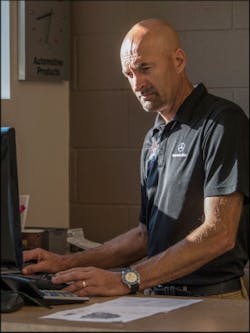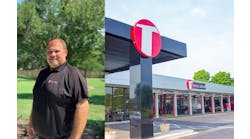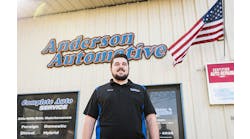WHEN JEFF NOL WAS A TECHNICIAN, he took his father’s advice to heart:
“The biggest thing he told me was nothing is ever given to you ,” Jeff says . “ If you want it, you’ll have to go after it and have to work hard to get it.”
That was telling advice for the young technician who, just 22 years later, would be running his father’s business , Arie Nol Auto Center, in Kentwood , Mich. And for those 22 years in the family business , Jeff was always convinced he could perform service writing better than his father.
But when Jeff and his wife, Debbie, finally took control of the business, he had a rude awakening: His time as a technician had created some bad service writing habits.
For technicians, Jeff says communication with customers isn’ t a huge concern . But for service writing? There might be nothing more important than proper communication.
“When you’re in the front, the customer is your number one priority,” Jeff says . “But when you’re in the back, you’re just dealing with the car. As a technician, customers don’t talk back to you, ask questions, or create any conversation. It’s interesting how difficult it is to go from the back room to the front.”
Arie Nol Auto Center
Location: Kentwood, Mich.
Size: 5,200 square feet
Staff: 7 (5 technicians, 2 owners (includes one service writer))
Annual Revenue: $1.4 million
Average Monthly Car Count: 274
So when circumstances forced Jeff in to a service writing role, he remembered his father's words: “If you want it, you’ll have to go after it and have to work hard to get it.”
And with that transition came growing pains, a ton of service writing training and a new customer-focused mindset—all of which led to a more efficient business.
THE BACKSTORY
Arie Nol hasn’t always been the $1.4 million business it is today. It was started by his father in 1976, and Jeff has seen the business grow from a small, three-bay shop to a 13-bay joint staffed with five technicians.
While he worked the shop floor in his father’s shop, Jeff ’s father took control of the service writing. But once Jeff and Debbie purchased the shop in 2000, he decided it was important that he became the face of the business.
“I never looked for a service advisor because I watched my dad do it for years and essentially felt, as the owner, it was my responsibility,” he says.
“I work in the office,” Debbie says. “I have no background in the business. I’m not a technician. There were a lot of questions I couldn’t answer. So, at first, we needed Jeff up front. He was supposed to serve as both a service writer and technician while we looked for a service writer.”
THE PROBLEM
Jeff describes himself as a “people person,” so his biggest flaw as a service writer wasn’t an inability to put on a friendly face for the customer— instead, he couldn’t seem to get out of his technician-focused approach to the repair process.
“Today, with the technology that’s in the vehicles, 90 percent of the people don’t know what’s going on in their car,” he says. “Most people just want to put a key in it and drive.
“The technician will come up and try to explain everything: What he’s done, how he did it, what parts were replaced. And the customer just doesn’t care. It’s getting tougher, with the technology these days, to explain to the customer why they’re spending ‘X amount of dollars’ on their car repairs.”
On top of his shortcomings as a communicator, Jeff overestimated his own abilities as a multitasker—being both a technician and a service writer didn’t allow the business to run efficiently.
“I thought that if I wrote service and worked in the back—which is where all the money is made—we would make more money,” he says. “But that was incorrect. Our profit margins were pretty bad.”
Because Jeff was spending so much time walking back and forth between the shop and the front desk, he wasn’t only losing money on poor labor margins, but he was also unable to allocate enough time to improving his abilities as a service writer.
On top of it all, it was upsetting the shop’s two other technicians to have Jeff transitioning between the back and the front, disrupting workflow and creating frustration during the repair and estimating process.
“We knew if we wanted to take it to the next level, we’d have to make a change,” Debbie says.
THE SOLUTION
That change came in the form of offsite management training and in-house coaching from Debbie.
As new business owners, the couple took every possible opportunity to attend management classes through NAPA, where Jeff picked up some key communication skills—and had his first real “ah-ha moment.”
“One day, a speaker said something that lit the light bulb in my head: I have to move the business forward, not backward,” he says. “I was inhibiting the shop’s efficiency, the repair process, my staff, all because I thought I was moving things forward by performing both positions. But, really, we were at a standstill.”
Thus, the two owners decided to hire a new full-time technician, and, for one month, Jeff dedicated himself entirely to his front desk duties.
Jeff and Debbie would review tickets that came through the shop, and she would give pointers on how to relay the proper, pertinent information that customers really needed to know, and not bog them down with technical talk.
Because Debbie knew as little about cars as most of their customers, she was the perfect test subject.
Through this in-house training program, Jeff developed a new vocabulary for customers.
“I try to find out what exactly is happening with their vehicle,” he says. “It’s my job to get enough information to help the technician begin his diagnoses of the problem. If it is in for maintenance, I ask a little about the usage of the vehicle. Do you mainly drive it on the highway or in the city? Is there anything else you think we need to look at? I’ve found that gives them the opportunity to add things like windshield wipers, a bulb that is out or a door that is squeaking. Little things that they may not have thought about having us look at.
“Most of the time, it’s more about showing than telling. We also have some tools available online and in the form of point-of-sale items that show the customer certain systems so it’s easier for them to see what we’re working on.”
And because of his technical expertise, transferring the information between the customers and technicians was a simple task.
“I try to use layman terms when speaking to customers,” Jeff says.
“Having worked as a technician for many years, I find it easy to communicate with the technicians in a way they understand and to simplify it for the customer when they need an explanation.”
THE AFTERMATH
“When we started looking at our numbers at the end of the first month of me being just up in the front and doing what I needed to do, our numbers increased,” Jeff says.
Before Jeff made the switch, the shop’s ARO hovered around $250. In 2002, the ARO rose to $285 with an average monthly car count of 139; the ARO rose again to $286 with an average of 232 cars per month in 2005. Today, the ARO stands at $446 with 264 cars repaired per month.
In addition to it all, the cost of adding one more technician to the back was outweighed by the sudden uptick in efficiency and increased profit margins. Parts margins have risen from 42 to 46 percent, and labor margins have gone from 55 to 64 percent.
“When he was spending more time as a service writer, things also flowed a lot better,” Debbie says. “The technicians seemed to be happier, and communication between everybody was much smoother.”
“I found out if I’m up in the front and doing the job that I need to do and letting the technicians do the job they need to do, profit margins started skyrocketing,” Jeff adds.
These days, the workload has increased so much that the shop expanded twice and has since added two more technicians.
Jeff not only dedicated his attention to the customer, but he can also now help Debbie with administrative duties during downtime and bring his technical expertise to the estimating process.
“When I go back there and they start talking about the problems with the vehicle, I understand everything they’re talking about,” Jeff says. “I know exactly what needs to be done, how it has to be done, and then I can explain it to the customer a lot more easily.”
That technical background has also made Jeff into a dynamite salesman—he says combining his wealth of mechanical knowledge with his extroverted personality allows him to easily explain to the customer what work needs to be done and break down the costs. Today, Jeff ’s closing ratio rests around 90 percent.
“We try to explain our repair process so the customer has a clear idea of how things happen,” Debbie says. “Especially if it is a first-time customer, we’ve learned through trial and error that they’ll be more satisfied with the experience if they know what to expect.”
EXPERT ADVICE TRAINING NEW ESTIMATORS
The service advisor position is a sales position. Most people don' t like to think of it that way, but it is. You’re selling something. It's a people skills job. The great technicians are good at what they do because they don’t really like dealing with people that much or selling to people. That's why they like cars— cars don' t talk back. People tend to talk back.
A technician is smart when it comes to the technical side of things. The technician says to a customer, “This is likely the problem.” And he or she is probably right. But if the car isn' t there, there's no way of being 100 percent sure. The customer hears, “Oh, well that's the problem. How much is that? ” Then the customer comes in and there's another problem and it's $200 more and they think they got cheated.
A great salesperson doesn' t need to know the technical side of it. He or she avoids all of that by saying, “I don' t know what the problem is. What I do know is we have an ASE Master cer tif ied technician who can run a series of tests and procedures on it, that can isolate that issue and f ind out what it is. Why don' t you come in and we'll inspect it and figure out what that is.”
I can train that out of a technician if the technician will let me. It's tough to do because you've got to train that technical exper tise out of them. But it can be done with enough work and an open mind.
THE TAKEAWAY
The mindset behind switching Jeff entirely to service writing duties has not only made the estimating and repair process more efficient at Arie Nol, but also signifies the change in mindset the co-owners required to propel the business forward.
“When you’re up in the front and making these decisions, it’s not just affecting you,” Jeff says. “You’ve got to make sure all your technicians and everybody underneath are treated as families.”



